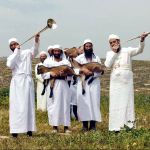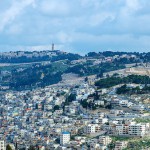Of all the Minor Prophets, Zechariah (זְכַרְיָה) reveals the clearest and the largest number of passages referencing the Messiah, many of which have already been fulfilled.
Zechariah, for instance, prophesies that the Messiah will ride on a donkey into Jerusalem as a humble, victorious king:
“Rejoice greatly, Daughter Zion! Shout, Daughter Jerusalem! See, your king comes to you, righteous and victorious, lowly and riding on a donkey, on a colt, the foal of a donkey.” (Zechariah 9:9)
Of course, this prophecy was fulfilled when Yeshua (Jesus) entered Jerusalem for the last time just before the Passover (Matthew 21:1–11).
This passage is not just concerned with Yeshua’s first coming, however, but also His second. It goes on to reveal that this humble King will one day magnificently rule “from sea to sea and from the River to the ends of the earth.” (Zechariah 9:10)
Zechariah tells us that Messiah will come again as savior, judge and, ultimately, as the righteous King of Kings and Lord of Lords ruling His people from Jerusalem (14:8–9).
This Hebrew prophet reassures us that in the Last Days, when the Messiah returns to His people, they will finally recognize Him, realize that they have “missed it” and react with a spirit of mourning.
The people of Jerusalem at that time will be moved by the “Spirit of grace and of supplication” that will be poured out on the inhabitants of Jerusalem at the Messiah’s coming.
“And I will pour out on the house of David and the inhabitants of Jerusalem a spirit of grace and supplication. They will look on Me, the one they have pierced, and they will mourn for Him as one mourns for an only child, and grieve bitterly for Him as one grieves for a firstborn son.” (12:10)
The Messiah will return to Jerusalem and finally be recognized by His people. Each family and clan will mourn together.

The above piece by Israeli artist Dalia Rosenfeld depicts the return of Messiah to His people. In the painting the Hebrew text of the Book of Zechariah is shown in the form of the tablets of the Law as mourning is seen throughout the city. The unblemished Lamb of God slain for the sins of His people appears at the center above the mourning inhabitants. The stark red background symbolizes the blood poured out by Yeshua and the cost of redemption.
Who was Zechariah?
Zechariah, whose name literally means the LORD has remembered, is one of the twelve Minor Prophets of the Tanakh (Old Testament), so called because the length of his writings (14 chapters) are not as vast as that of Isaiah or Ezekiel, for instance, who are classified as Major Prophets.
Zechariah prophesied to the kingdom of Judah with the distinction of being the grandson of Iddo the High Priest, making him of priestly extraction. In Nehemiah 12:16, he is even described as being the head of Iddo’s priestly family.
He began his ministry preaching repentance saying, “This is what the Lord Almighty says: ‘Return to me,’ declares the Lord Almighty, ‘and I will return to you,’ … ‘Turn from your evil ways and your evil practices.’” (1:3–4)
Zechariah 1:1 and Haggai 1:1 reveal that he began his ministry around the month of November in 520 BC, two months after Haggai began his.
This was about 16 years after the return of the first group of Jews from Babylonia with Zerubbabel (Nehemiah 12:4) when Cyrus issued his edict for the reconstruction of the Temple in Jerusalem.
Zechariah is thought to have been a motivating force toward its completion, as well as instrumental in the reestablishment of the Temple priesthood.
His chief concern, however, was the establishment of spiritual priorities among those who had returned from exile to Zion.
He guarded against the establishment of pagan cults and taught repentance and submission to the Lord as the basis for redemption from sin, restoration of God’s blessings, and the outpouring of the Ruach HaKodesh (Holy Spirit).
Although Zechariah addressed the issues of his day, his prophecies reach far beyond them into the time of Yeshua and, to a large extent, the end times in which we are living.
We see that this so-called minor prophet figure is prominently remembered in the Brit Chadashah (New Testament), which contains 41 citations or allusions to his prophecies. (ldolphin)
Yeshua describes Zechariah as a rejected prophet, martyred “between the temple and the altar.” (Mathew 23:35; Luke 11:51)

Some contend that this tomb cut out of the rock at the foot of the Mount of Olives is the tomb of Zechariah.
The Man Among the Myrtle Trees
The Lord spoke to Zechariah through visions rich in symbolism, including one in which the Angel of the Lord was standing among myrtle trees (1:10).
Myrtle is one of the four species of plant used to make the temporary shelters people live in during Sukkot (Feast of Tabernacles; see Nehemiah 8:15). This plant was also carried around the altar in the Temple and is mentioned five times in this vision.
The symbolism of numbers is significant in Jewish interpretation of Scripture. The number five, for instance, is considered to be “the numeric expression of a group, gathering its divergent parts into a complete unit.” (Jewish Wisdom in the Numbers, p. 89)
This number, therefore, may hint at the return of the Jewish People to the Land. Indeed, Zechariah is addressing the people who have returned to Jerusalem and begun to rebuild.
In the vision, the Angel of the Lord explains to Zechariah that He is not happy with the nations. Although He had allowed them to punish Judah for their sins, they went too far (1:14).
Throughout the Book of Zechariah, the nations are presented as being indifferent and even hostile to Jerusalem and the Jewish People.
How very like our times when the nations are silent regarding those who terrorize Israel and hostile toward Israel for defending herself. Though God’s thoughts are for Israel, the nations’ thoughts are far from the mind of God. We can understand from Zechariah that God does not want us to be indifferent to Jerusalem. He certainly is not.
In fact, chapter 14 of Zechariah describes the triumphant return of Messiah to His Land — not humbly riding on a donkey but victoriously standing on the Mount of Olives.
On that day, “Living water will flow out from Jerusalem, half of it east to the Dead Sea and half of it west to the Mediterranean Sea, … The Lord will be king over the whole earth. On that day there will be one Lord, and His name the only name.” (14:8–9)
Messiah will reign from Jerusalem and each year the people of all the nations will go up to Jerusalem to “worship the King, the Lord Almighty, and to celebrate the Festival of Tabernacles.” (14:16)
Sukkot is a week of joy as those who celebrate it remember how the Lord Himself tabernacled with His children in the wilderness and will do so again in the last days.
Yet, the seventh day of the feast has special end-time significance: “Hoshana Rabbah, the seventh day of Sukkot, has a solemn undertone, it is closely linked to Yom Kippur, for it is on this day that the final seal is placed on the verdict that was pronounced on Yom Kippur,” writes Avraham Finkel in Essence of the Holy Days.
It is fitting then that the Lord would require the celebration of this end-time feast during the Messianic reign to remember the glorious salvation He has given those who did not reject Him.
“This final day of celebrating the Harvest, and Ingathering, therefore, pictures the final stage of God’s plan of salvation — the ‘Last Great Day,’ or the ‘Great White Throne Judgment’! It literally pictures the final day of ‘judgment’ and sealing those who will receive eternal life (compare Revelation 20:11–15), as opposed to those who will suffer the second and final death penalty (v.14–15).” (Hope of Israel)
We see a foreshadowing of this end-time event with the annual Feast of Tabernacles celebration, which is organized by the International Christian Embassy in Jerusalem.

Many from nations around the world come to be a blessing and celebrate God’s plan for Israel at Sukkot.
Jerusalem and the Divine Presence
The Lord calls Jerusalem “My house” and promises that He will rebuild it (1:16).
This is a clear assurance of His Divine Presence among His people in Jerusalem. Furthermore, He also promises that through His Divine blessing, He will return prosperity in many manifestations.
“This is what the Lord Almighty says: ‘My towns will again overflow with prosperity, and the Lord will again comfort Zion and choose Jerusalem.’” (1:17)
The Lord calls for the Jewish People to return to the Land — not merely from Babylon but from the “four winds of heaven” where the Lord says, “I have scattered you.” (2:6)
“Whoever touches you touches the apple of His eye,” declares Zechariah. (2:8)
Adonai’s protection of Jerusalem and His people is so personal that He says in the Last Days, “I myself will be a wall of fire around it … and I will be its glory within.’” (2:4)
“Shout and be glad, Daughter Zion. For I am coming, and I will live among you.” (2:10)
At that time there will be a one-state solution that wipes out all strife in the Land, which the Lord will rule over — “The LORD will inherit Judah as His portion in the holy land and will again choose Jerusalem.” (2:12)
The Lord Promises to Bless Jerusalem
Again in chapter 8 the Lord assures us through Zechariah that He has not abandoned His people.
“I will return to Zion and dwell in Jerusalem. Then Jerusalem will be called the Faithful City, and the mountain of the Lord Almighty will be called the Holy Mountain.” (8:3)
Jerusalem will be a place where both old and young are living in peace:
“Once again men and women of ripe old age will sit in the streets of Jerusalem, each of them with cane in hand because of their age. The city streets will be filled with boys and girls playing there.” (8:4–5)
The prophet goes on to describe events that have come to pass in our time — “I will save My people from the countries of the east and the west. I will bring them back to live in Jerusalem; they will be My people, and I will be faithful and righteous to them as their God.” (8:7–8)
Zechariah also prophesies that many from the nations will act on the knowledge that God is with His people:
“In those days ten people from all languages and nations will take firm hold of one Jew by the hem of his robe and say, ‘Let us go with you, because we have heard that God is with you.’” (8:23)

A blessing is recited over two Jewish youth at the Western Wall, also known as the Wailing Wall and the Kotel. (Photo by Kyle Taylor)
The Righteous Branch
“I am going to bring My servant, the Branch.” (Zechariah 3:8)
Before this glorious reign of the Messiah, He must first deal with sin and establish a way for those who are not His people to become His people.
The Lord does this because He loves all mankind and does not want anyone to perish.
In the third chapter of Zechariah, the prophet sees a vision concerning God’s servant, the Branch, which promises that the “sin of this land” will be removed in a single day.
Likewise, chapter 13 describes a fountain of water opening up to the house of David with waters that will cleanse the people from their sins.
God promises to forgive His people and restore them to their rightful place through this Righteous Branch.
In chapter six, “the Branch” is identified as being the high priest Joshua, son of Jozadak and it is said that he will build the Temple of the Lord and rule from it as king —“he will be a priest on his throne.” (6:13)
And yet, Zechariah clearly tells us that Joshua and his associates are merely “men symbolic of things to come.”
Joshua is an image of Yeshua (a name derivative of Yehoshua or Joshua) who the Bible tells us will reign “in the order of Melchizedek,” who was both high priest and king of Salem (Jerusalem). (Hebrews 6:20)
Zechariah does not present the only vision concerning the Branch. Isaiah prophesies that the Branch will come from David (Isaiah 11:1–5). Jeremiah prophesies that the Righteous Branch will reign as king and that king will be called the LORD our Righteousness (Jeremiah 23:5–6; 33:14–17).
Messianic prophecies throughout the Tanakh reveal this Righteous Branch to be Yeshua HaMashiach.

A Jewish teen wearing a tallit (prayer shawl), tefillin (phylacteries), and a kippah (head covering) prays at the Western (Wailing) Wall in Jerusalem. (Photo by the State of Israel)
The Lord Will Care for Judah
“I will restore them because I have compassion on them. They will be as though I had not rejected them.” (Zechariah 10:6)
Since the regathering of His people from the “four winds of heaven” into the Land of Israel, God’s promise of protection fulfilled. No Arab country has been able to defeat the state of Israel in modern times.
Politically and diplomatically, for the United Nations and the European Union, Israel is a constant source of frustration. Western nations try to sanction, boycott, and hurl accusations of war crimes at Israel. At the same time, Arab nations and regional terror groups devise plans to wipe Israel off the map.
While God’s promise of protection is true and Israeli children are indeed playing in the streets of cities without walls, it is tragic that these same children must flee to bomb shelters and endure post traumatic stress from terror and rocket attacks, just because they are Jews — chosen by God to fulfill His grand plan in the earth.
The good news is that the Lord’s plan ends in victory for His Name, His People, and His Land:
“I am going to make Jerusalem a cup that sends all the surrounding peoples reeling. Judah will be besieged as well as Jerusalem. On that day, when all the nations of the earth are gathered against her, I will make Jerusalem an immovable rock for all the nations. All who try to move it will injure themselves.” (12:2–3)
That prophecy is, even now, unfolding. And as the nations continue to come against Jerusalem and the Jewish People, they will find that they are making war on the Lord of Hosts — a losing proposition.
The Righteous Branch offers everyone the opportunity to share in His victory and be included in the end-time Harvest that will be gathered into the New Jerusalem and live under the eternal, divine protection of the LORD of Hosts. Halleluyah!






















